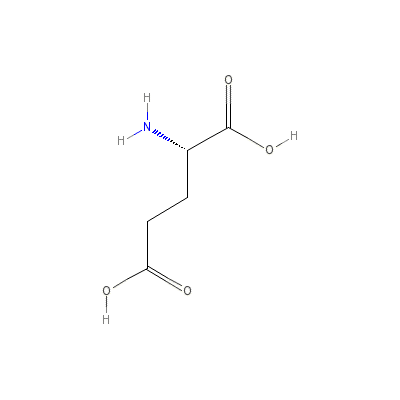a-Aminoglutaric acid




a-Aminoglutaric acid Brand names, a-Aminoglutaric acid Analogs
- (2S)-2-Aminopentanedioic acid
- (S)-(+)-Glutamic acid
- (S)-2-Aminopentanedioic acid
- (S)-Glutamic acid
- 1-Aminopropane-1,3-dicarboxylic acid
- 2-Aminoglutaric acid
- 2-Aminopentanedioic acid
- Aciglut
- E 620
- Glusate
- Glutacid
- Glutamic acid
- Glutamic acid, L-
- Glutamicol
- Glutamidex
- Glutaminic acid
- Glutaminol
- Glutaton
- L-(+)-Glutamic acid
- L-Glutamate
- L-Glutamic acid
- L-Glutamic acid (JAN)
- L-Glutaminic acid
- L-a-Aminoglutaric acid
- Pentanedioic acid, 2-amino-, (S)-
- a-Aminoglutaric acid
- a-Glutamic acid
a-Aminoglutaric acid Brand Names Mixture
- No information avaliable
a-Aminoglutaric acid Chemical_Formula
C5H9N1O4
a-Aminoglutaric acid RX_link
No information avaliable
a-Aminoglutaric acid fda sheet
a-Aminoglutaric acid msds (material safety sheet)
a-Aminoglutaric acid Synthesis Reference
No information avaliable
a-Aminoglutaric acid Molecular Weight
147.130 g/mol
a-Aminoglutaric acid Melting Point
205 oC
a-Aminoglutaric acid H2O Solubility
No information avaliable
a-Aminoglutaric acid State
Solid, white crystalline powder
a-Aminoglutaric acid LogP
-1.43 +/- 0.31
a-Aminoglutaric acid Dosage Forms
No information avaliable
a-Aminoglutaric acid Indication
In addition to being one of the building blocks in protein synthesis, it is the most widespread neurotransmitter in brain function, as an excitatory neurotransmitter and as a precursor for the synthesis of GABA in GABAergic neurons.
a-Aminoglutaric acid Pharmacology
Considered to be nature's "Brain food" by improving mental capacities; helps speed the healing of ulcers; gives a "lift" from fatigue; helps control alcoholism, schizophrenia and the craving for sugar.
a-Aminoglutaric acid Absorption
Absorbed from the lumen of the small intestine into the enterocytes.Absorption is efficient and occurs by an active transport mechanism.
a-Aminoglutaric acid side effects and Toxicity
Glutamate causes neuronal damage and eventual cell death, particularly when NMDA receptors are activated, High dosages of glutamic acid may include symptoms such as headaches and neurological problems.
a-Aminoglutaric acid Patient Information
It is an important excitatory neurotransmitter, and glutamic acid is also important in the metabolism of sugars and fats. It helps with the transportation of potassium across the blood-brain barrier, although itself does not pass this barrier that easily. It also shows promise in the future treatment of neurological conditions, ulcers, hypoglycemic come, muscular dystrophy, epilepsy, Parkinson's, and mental retardation. Glutamic acid can be used as fuel in the brain, and can attach itself to nitrogen atoms in the process of forming glutamine, and this action also detoxifies the body of ammonia. This action is the only way in which the brain can be detoxified from ammonia. The fluid produced by the prostate gland also contains amounts of glutamic acid, and may play a role in the normal function of the prostate.
a-Aminoglutaric acid Organisms Affected
Humans and other mammals














